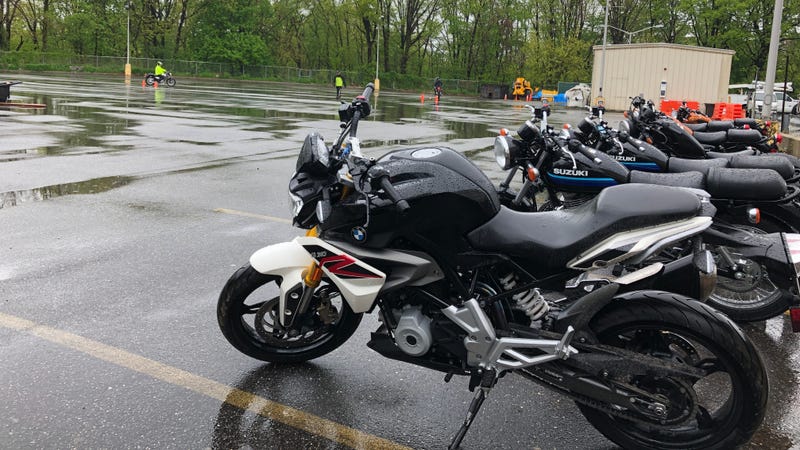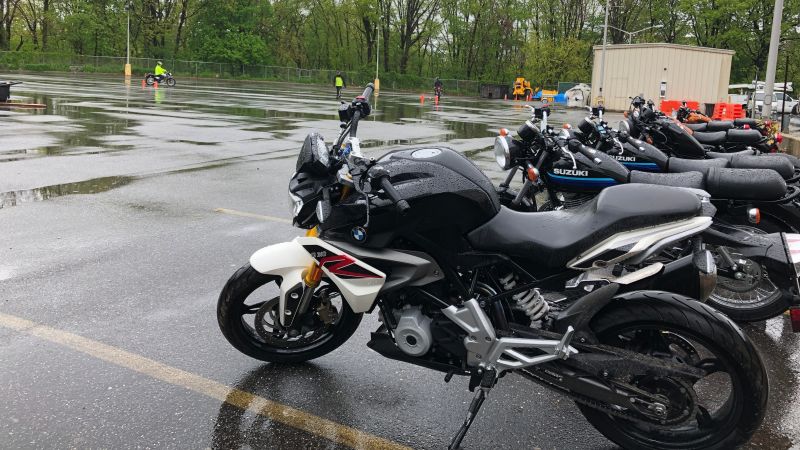
I took and passed the Motorcycle Safety Foundation’s basic riding course this past weekend, the one you need in New York state to get your motorcycle endorsement without taking a road test. It was not easy, but I did leave with a pretty high level of confidence in my ability to safely operate a bike. I was surprised to learn what it taught me about regular-car driving, too.
(Full Disclosure: MSF did not charge me for the two-day course, which normally costs around $350 depending on where you take it. MSF waives the fee for media, in an effort to spread the gospel of motorcycling in an age where it is falling further and further out of fashion, at least in the United States. MSF is a not-for-profit organization, but it is supported in part by motorcycle makers like BMW, Honda, and Harley-Davidson. The outfit also gave me some food, a helmet, gloves, and three wonderful instructors.)
I had intended to take the course ever since I went to Milwaukee for Harley-Davidson’s 115th anniversary last year and wrote too many words about it. I had for years considered motorcycling needlessly dangerous and stupid, two things I was actually fine with, if only I had not already had a series of other habits—mainly things you would associate with bars, in addition to using Twitter—that were also needlessly dangerous and stupid.
Still, after the Harley story, I knew I needed to put my money where my mouth is and at least take the course and give it a shot. So I emailed MSF, and while I had missed the fall window for the course, we made plans to do it this spring. Which is how I found myself at a community college in Bayside, Queens, on a cool Saturday in May, with eight or nine other newbs.
We started in a basement classroom and went through the basics of motorcycling, like where the controls are, how to do a pre-ride inspection, what safety gear to wear, and how to turn a motorcycle on.
Advertisement
Most of what we talked about, though, was safety. There’s no escaping that motorcycles can be death machines, our instructors told us in so many words, but there’s also plenty you can do to mitigate that. And their advice was much more than “Wear a helmet,” though they said that too. (Virtually none of the Harley riders I saw in Milwaukee wore helmets, though there was plenty of leather.) Beyond a helmet, you need a jacket (probably with armor), long pants, boots that cover your ankles, and gloves, all of which might be the difference between having skin and not after a spill.
But perhaps most of all what you need to be aware, constantly be mapping escape routes if anything goes awry, scanning far, then near, and then to your sides, over and over again while you’re moving, and making mental notes the whole time.
This is all good practice when you’re operating any kind of vehicle, of course, but essential when you’re riding a bike, and made more difficult because manual motorcycles are complex machines to ride, or far more complex than a typical commuter car.
Advertisement
You’ve got all four of your limbs in action, sometimes all at once. At your right hand is the front brake, throttle, and engine cut-off button; at your left hand is the clutch, turn signals, and horn; at your right foot is the rear brake, and at your left foot is the gear shifter.
When braking to a stop from speed, for example, you’re going to be pressing and pulling and pushing with every extremity.

Advertisement
The mechanical stuff is all just a part of riding though, and even in my short experience, I could see a lot of things quickly become instinctual.
A lot of the awareness stuff, though, is very much not, like the concept of target fixation, focussing on something in the distance ahead—an obstacle, perhaps, or a fence—for too long, inadvertently leading your bike straight into it. In those moments, you must consciously tell your eyes to keep scanning.
The point of all this is for you to assume that you’re invisible to drivers, which in some cases is literally true—if you’re in someone’s blind spot, for example—but in most other cases is figuratively so, since a lot of drivers don’t give a shit about bikers of any stripe, or don’t care enough about anything to be mindful.
Advertisement
I think these concepts apply to drivers, too since when I drove away from the course on Sunday I had a new awareness for just how much danger is out there.
I considered myself a pretty conservative and defensive driver—having learned the hard way on more than a few occasions—before the course. But if anything, it’s taught me to bend even further in that direction, riding or driving, since things on the road can go south so quickly.
Modern cars—even the fast, sporty ones or maybe especially the fast, sporty ones—have a dissociative effect on drivers relative to danger. This is largely a good thing when it comes to comfort, but when 100 mph feels like 25 mph it’s easy to forget that 100 mph is exponentially more dangerous than 25 mph. Even in my 2008 Honda Fit—which definitely feels like 100 mph at 100 mph—it’s easy to take things for granted.
Advertisement
On a motorcycle, it’s impossible to take anything for granted, since everything—even just sitting on the damn thing—feels a little dangerous. Which is a central appeal, of course, along with the sheer physicality of riding the thing.
I kind of rolled my eyes every time a Harley guy told me in Milwaukee their trip there from wherever they had come from had been “epic,” but I get it now. When everything’s clicking, you feel a symbiosis with the machine beneath you that isn’t possible in a car.
And you can smell the breeze, as you think of purple ways to describe how you’re feeling. And then you remember that you need to get your eyes back on the road.













